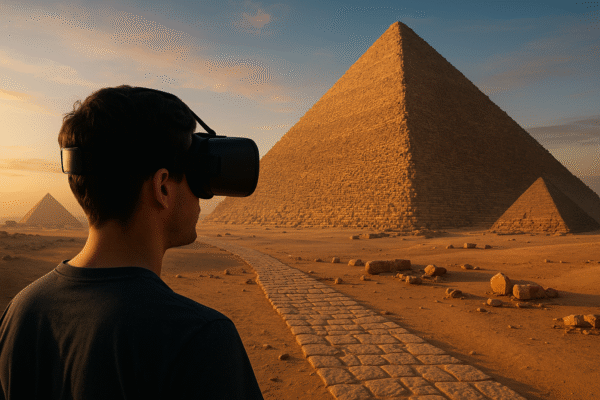Egypt has taken a bold step in cultural tourism with the launch of a 3D virtual reality experience at the Giza Pyramids. The project combines cutting-edge technology with the country’s ancient history, offering visitors a new way to engage with one of the world’s most famous landmarks.
A New Way to Experience History
Created by the Sound and Light Company, the VR journey is part of a broader plan to modernize Egypt’s tourism industry. It blends storytelling, 3D projection mapping, and VR headsets to immerse visitors in Egypt’s past. Rather than just looking at monuments, tourists can now step into reconstructed scenes from thousands of years ago.
Inside a dedicated VR venue, visitors can enter the tomb of King Tutankhamun, view golden treasures, and admire detailed wall carvings. They can witness the building of the Great Pyramids, gaining insight into ancient engineering techniques. The program also includes a dive into the lost city of Alexandria, revealing ruins beneath the Mediterranean Sea.
More Than Just Viewing
Guests can learn about mummification rituals, ancient ceremonies, and everyday life in pharaonic times. By interacting with virtual artifacts, visitors develop a deeper appreciation for Egypt’s cultural and spiritual traditions.
The VR attraction builds on the country’s famous Sound and Light shows, which have been running since the 1960s at sites like Karnak and Abu Simbel. These shows used lights, narration, and music to bring monuments to life. The new system takes this further, creating experiences where guests move through history instead of just watching it unfold.
Appealing to a Wider Audience
This transformation is designed to connect with younger generations and tech-focused travelers. It also makes Egypt’s heritage more accessible for people who may not be able to explore the monuments physically. With VR, anyone can experience the grandeur of Egypt’s past, regardless of mobility or age.
Future Expansion Plans
The Ministry of Public Business Sector aims to bring similar VR experiences to other historic locations. Karnak could feature 3D reconstructions of ancient gods and royal processions. Abu Simbel may offer a virtual tour of its massive statues during the annual sun alignment event. Edfu and Qaitbay Citadel are also on the list for future upgrades.
Each location will combine immersive visuals with historical accuracy, ensuring visitors can step back in time wherever they travel in Egypt.
Boosting Tourism and the Economy
Beyond creating unforgettable memories, the VR initiative supports Egypt’s economic goals. By offering more activities at heritage sites, tourists are encouraged to stay longer, spend more, and explore nearby towns. Local restaurants, hotels, and markets all benefit from this extended engagement.
Interactive experiences also inspire repeat visits. Tourists who have already seen Egypt’s landmarks may return to try the new VR journeys. This helps sustain visitor numbers year-round, reducing seasonal dips in tourism.
Education Meets Entertainment
The program is designed to be both fun and informative. Families, school groups, and history enthusiasts can all enjoy it. Visitors can control the pace of their exploration, spend extra time in areas of interest, and access detailed information as they go.
This hands-on approach makes learning about ancient Egypt more engaging than reading plaques or listening to a standard tour guide. It creates personal connections with history, making the stories more memorable.
Technology as a Preservation Tool
By using VR, Egypt can showcase fragile sites without putting them at risk from heavy tourist traffic. Virtual access allows people to see delicate artifacts and structures that may not be open to the public for conservation reasons.
This balance between accessibility and preservation ensures that Egypt’s treasures can be enjoyed by future generations without damage from over-visitation.
A Global Tourism Leader
With this initiative, Egypt is positioning itself as a pioneer in merging technology with heritage. The VR experience keeps the authenticity of cultural storytelling while adding layers of interactivity and immersion.
As technology evolves, these experiences can be updated with new features, creating even more realistic journeys through history. This adaptability ensures Egypt remains at the forefront of cultural tourism innovation.
Conclusion
The 3D VR experience at the Giza Pyramids marks a new chapter in how travelers interact with history. It combines education, entertainment, and cultural preservation in one immersive package. Tourists leave not just with photos, but with vivid memories of walking alongside ancient builders, exploring royal tombs, and uncovering lost cities.
Egypt has shown that the past can be experienced in new ways without losing its magic. Through this mix of heritage and high-tech, the country offers visitors a deeper connection to its remarkable story—one that will inspire curiosity for years to come.
For more travel news like this, keep reading Global Travel Wire



















